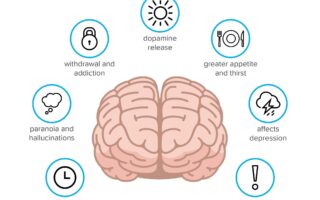In the ever-evolving landscape of cannabis research and public perception, one question often surfaces amid the swirling clouds of smoke: “Has anyone died from weed?” This inquiry, steeped in curiosity and sometimes trepidation, invites us to explore the complex relationship between a substance long touted for its medicinal benefits and the fears that linger in its shadow. While stories of extravagant highs and euphoric escapes fill our social feeds, the darker corners of this conversation remain less illuminated. As we delve into the science, myths, and real-world implications surrounding cannabis use, we aim to shed light on its safety profile, the potential risks involved, and ultimately, the truth behind this provocative question. In a society increasingly lenient towards legalization, understanding the nuances is essential—not just for users, but for anyone touched by the changing tides of cannabis culture.
Table of Contents
- Understanding the Risks Associated with Cannabis Consumption
- Exploring Case Studies: Documented Fatalities Linked to Marijuana
- Distinguishing Between Legal Frameworks and Public Perception
- Promoting Safe Use: Recommendations for Responsible Cannabis Consumption
- Q&A
- Wrapping Up
Understanding the Risks Associated with Cannabis Consumption
While the perception of cannabis as a relatively harmless substance persists, it is essential to delve deeper into the potential hazards linked to its consumption. Cannabis can affect individuals differently, influenced by factors such as dosage, potency, method of consumption, and individual tolerance. Some of the primary risks include:
- Mental Health Effects: Anxiety, paranoia, and psychosis can arise, especially in those predisposed to such conditions.
- Impaired Motor Skills: Cannabis use can impair coordination and reaction time, raising the risk of accidents.
- Dependency and Withdrawal: Regular use can lead to dependency, resulting in withdrawal symptoms when consumption stops.
In rare cases, extreme adverse effects, although not typically fatal, have been reported. Respiratory issues can arise from smoking, and overconsumption of edibles may lead to severe distress, prompting medical assistance. Below is a simplified breakdown of some known, albeit uncommon, severe effects:
| Effect | Description |
|---|---|
| Cannabinoid Hyperemesis Syndrome | Severe nausea and vomiting with frequent cannabis use. |
| Cardiac Issues | Increased heart rate can lead to complications, especially in those with preexisting conditions. |
Exploring Case Studies: Documented Fatalities Linked to Marijuana
While the debate surrounding cannabis continues, the examination of documented fatalities linked to marijuana reveals intriguing, albeit complex, narratives. Cases have arisen where either direct consumption or ancillary factors contributed to tragic outcomes. Some highlighted circumstances include:
- Substance Interaction: Instances where marijuana was mixed with other illicit drugs, leading to adverse reactions.
- Underlying Health Issues: Fatalities occurring in individuals with pre-existing conditions exacerbated by marijuana use.
- Driving Incidents: Accidents occurring under the influence of cannabis, resulting in loss of life and severe consequences.
Data from various studies shows a varied landscape of circumstances, often attributing causes of death to factors beyond just marijuana itself. A closer inspection of key case studies might include notable incidents:
| Case Study | Circumstance | Outcome |
|---|---|---|
| Driver Under the Influence | Car accident resulting from impaired judgment | Fatality of driver and passenger |
| Polydrug Use | Cannabis combined with opioids | Overdose leading to death |
| Health Complications | Severe panic attack in asthmatic patients | Asphyxiation |
Distinguishing Between Legal Frameworks and Public Perception
The legal landscape surrounding the use of cannabis is constantly evolving, influenced by shifting policies and changing societal norms. Many jurisdictions have embraced legalization, creating frameworks that govern its use and possession. However, public perception often lags behind these legal advancements. Individuals regularly draw conclusions based on anecdotal evidence or sensationalized media reports rather than the expansive body of research available. This leads to a significant discrepancy between what the law stipulates and what the community believes, often resulting in misunderstandings about the impacts of cannabis.
Understanding this divide is essential, especially when discussing health implications and safety concerns. Key factors that contribute to shaping public perception include:
- Media Representation: A focus on negative outcomes can skew public opinion.
- Personal Experiences: Individual stories and testimonials dramatically influence perceptions.
- Education and Awareness: The level of information available about cannabis can alter public attitudes.
Moreover, surveys reveal a myriad of opinions on cannabis safety and its associated risks, underscoring the need for informed dialogue. A recent survey highlighted the contrasting views on cannabis legalization:
| Age Group | Support Legalization | Concerned About Health Risks |
|---|---|---|
| 18-24 | 75% | 20% |
| 25-34 | 65% | 30% |
| 35-44 | 50% | 40% |
| 45+ | 40% | 55% |
Promoting Safe Use: Recommendations for Responsible Cannabis Consumption
To ensure a positive experience with cannabis, it’s vital to approach consumption responsibly. Here are some key recommendations to consider for safe use:
- Start Low and Go Slow: If you’re new to cannabis, begin with a low dosage to gauge your body’s reaction.
- Know Your Strain: Different strains have varying effects; do your research to find one that suits your preferences.
- Choose the Right Setting: Be in a comfortable environment, ideally with trusted friends, to enhance safety and enjoyment.
- Stay Hydrated: Drink water to prevent dehydration, especially if consuming edibles or smoking.
Additionally, understanding your limits is crucial. For those who may have a history of mental health issues or are on medications, consulting a healthcare professional beforehand is wise. Consider the following factors to help maintain moderation:
| Factor | Consideration |
|---|---|
| Time of Day | Limit use to evenings or weekends to minimize impact on daily activities. |
| Substance Interaction | Avoid mixing cannabis with alcohol or other drugs to prevent adverse effects. |
| Personal Tolerance | Regular consumers should be mindful of increased tolerance levels over time. |
Q&A
Q&A: Has Anyone Died from Weed?
Q1: Is it true that marijuana can be fatal?
A1: The debate surrounding marijuana and its effects has been ongoing for decades. While there have been isolated incidents where marijuana use was associated with fatal outcomes, such as accidents or risky behaviors, direct deaths solely attributed to marijuana overdoses are extremely rare. Current research suggests that the risk of fatal overdose from marijuana is significantly lower than that associated with many legal substances, including alcohol and tobacco.
Q2: What about the effects of synthetic cannabinoids? Are they more dangerous?
A2: Synthetic cannabinoids, often marketed as “spice” or “K2,” can pose a higher risk compared to natural cannabis. These substances are chemically engineered to mimic THC, the active ingredient in marijuana, but they can vary widely in potency and composition. Reports of severe side effects and even fatalities linked to synthetic cannabinoids are more common, primarily due to their unpredictable nature and intensity.
Q3: Can someone die from anxiety or panic attacks induced by marijuana?
A3: While marijuana can induce anxiety and panic attacks in some users, particularly those who are inexperienced or predisposed to anxiety disorders, these reactions are not typically fatal. However, they can lead to dangerous situations, such as impaired judgment while driving. It’s essential for users to understand their limits and recognize the potential effects of marijuana on their mental state.
Q4: What statistics are available regarding marijuana-related deaths?
A4: Reliable statistics specifically linking marijuana use to direct fatalities are scarce. The Centers for Disease Control and Prevention (CDC) and other health organizations have not established a causal relationship between marijuana alone and deaths. However, they do emphasize the importance of responsible use and awareness of its effects, especially among vulnerable populations.
Q5: Are there any indirect ways marijuana could contribute to someone’s death?
A5: Yes, marijuana can indirectly contribute to fatalities. For instance, impaired driving under the influence of marijuana can lead to accidents. Additionally, individuals with certain medical conditions might face complications when using marijuana, which could potentially lead to severe health issues. The context of use—environment, dosage, and individual health—is crucial in assessing risks.
Q6: What can we conclude about the risks associated with marijuana use?
A6: While marijuana is generally considered safe in terms of direct overdose risk, it’s not without dangers. Understanding personal health, using responsibly, and being aware of legal implications and potential impacts on mental health are essential. As research continues to evolve, a balanced perspective on both the benefits and risks of marijuana will pave the way for informed decision-making.
Wrapping Up
As the smoke settles and the debate continues, we’ve uncovered the nuanced layers surrounding the question of whether anyone has died from weed. While studies and anecdotal evidence paint a complex picture, one thing is clear: marijuana, like many substances, carries risks that vary from person to person. From health risks associated with heavy usage to implications tied to its consumption methods, it’s vital to approach this topic with both curiosity and caution. As society evolves and our understanding of cannabis deepens, it becomes increasingly important to engage in open and informed discussions, rather than sensationalized narratives. knowledge is our best ally—an essential tool in navigating the ever-shifting landscape of cannabis use and its implications on health and safety. So, as we exhale these insights, let’s remain vigilant and proactive in our pursuit of understanding for generations to come.



